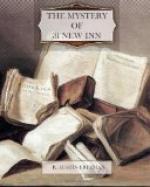I took the little “restoration,” and, holding it up before my eyes, moved it to and fro as I looked through it at the window.
“It was not a lens,” I pronounced eventually.
“No,” Thorndyke agreed, “it was not a lens.”
“And so cannot have been a spectacle-glass. But the surface was curved—one side convex and the other concave—and the little piece that remains of the original edge seems to have been ground to fit a bezel or frame. I should say that these are portions of a watch-glass.”
“That is Polton’s opinion,” said Thorndyke, “and I think you are both wrong.”
“What do you say to the glass of a miniature or locket?”
“That is rather more probable, but it is not my view.”
“What do you think it is?” I asked. But Thorndyke was not to be drawn.
“I am submitting the problem for solution by my learned friend,” he replied with an exasperating smile, and then added: “I don’t say that you and Polton are wrong; only that I don’t agree with you. Perhaps you had better make a note of the properties of this object, and consider it at your leisure when you are ruminating on the other data referring to the Blackmore case.”
“My ruminations,” I said, “always lead me back to the same point.”
“But you mustn’t let them,” he replied. “Shuffle your data about. Invent hypotheses. Never mind if they seem rather wild. Don’t put them aside on that account. Take the first hypothesis that you can invent and test it thoroughly with your facts. You will probably have to reject it, but you will be certain to have learned something new. Then try again with a fresh one. You remember what I told you of my methods when I began this branch of practice and had plenty of time on my hands?”
“I am not sure that I do.”
“Well, I used to occupy my leisure in constructing imaginary cases, mostly criminal, for the purpose of study and for the acquirement of experience. For instance, I would devise an ingenious fraud and would plan it in detail, taking every precaution that I could think of against failure or detection, considering, and elaborately providing for, every imaginable contingency. For the time being, my entire attention was concentrated on it, making it as perfect and secure and undetectable as I could with the knowledge and ingenuity at my command. I behaved exactly as if I were proposing actually to carry it out, and my life or liberty depended on its success—excepting that I made full notes of every detail of the scheme. Then when my plans were as complete as I could make them, and I could think of no way in which to improve them, I changed sides and considered the case from the standpoint of detection. I analysed the case, I picked out its inherent and unavoidable weaknesses, and, especially, I noted the respects in which a fraudulent proceeding of a particular kind differed from the bona fide proceeding that it simulated. The exercise was invaluable to me. I acquired as much experience from those imaginary cases as I should from real ones, and in addition, I learned a method which is the one that I practise to this day.”




